Deza M.M., Laurent M. Geometry of Cuts and Metrics
Подождите немного. Документ загружается.

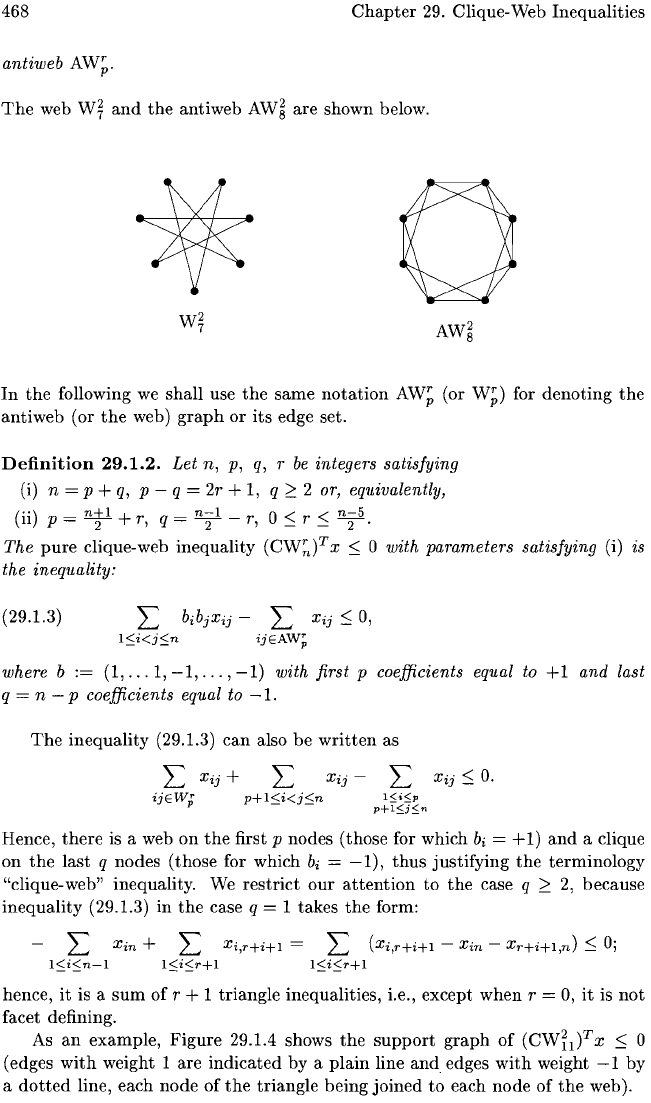
468
Chapter
29. Clique-Web Inequalities
antiweb
AW~.
The
web
W~
and
the
antiweb
AW§
are shown below.
AW§
In the following
we
shall use
the
same
notation
AW~
(or
W~)
for denoting
the
antiweb (or
the
web)
graph
or
its
edge set.
Definition
29.1.2.
Let
n,
p,
q,
r
be
integers satisfying
(i)
n = p +
q,
p - q = 2r + 1,
q::::
2 or, equivalently,
(ii) p =
nt
1
+ r, q =
n;-1
-
r,
0::::;
r
::::;
n;-5.
The
pure
clique-web inequality
(CW~)T
x
::::;
0 with parameters satisfying (i) is
the inequality:
(29.1.3)
L bibjXij - L
Xij::::;
0,
where b
.-
(1,
...
1,
-1,
...
,
-1)
with first p coefficients equal to
+1
and last
q
= n - p coefficients equal to
-1.
The
inequality (29.1.3)
can
also be
written
as
L
Xij+
L
Xij-
ijEW;
p+1:'Oi<j:'On
L
Xij::::;
O.
l<i<p
p+l~j~n
Hence,
there
is a web
on
the
first p nodes (those for which
bi
= +
1)
and
a clique
on
the
last
q nodes (those for which
bi
=
-1),
thus
justifying
the
terminology
"clique-web" inequality. We
restrict
our
attention
to
the
case q
::::
2,
because
inequality (29.1.3) in
the
case q = 1 takes
the
form:
L
Xin
+ L
Xi,r+i+1
= L
(Xi,r+i+1
-
Xin
- X
r
+i+1,n)
::::;
0;
19:'On-1
1:'Oi:'Or+1
1:'Oi:'Or+1
hence,
it
is a
sum
of
r + 1 triangle inequalities, i.e., except
when
r =
0,
it
is
not
facet defining.
As
an
example, Figure 29.1.4 shows
the
support
graph
of
(CWi1)T
x
::::;
0
(edges
with
weight 1 are indicated by a
plain
line
and
edges
with
weight
-1
by
a
dotted
line, each node
of
the
triangle being joined
to
each node
of
the
web).
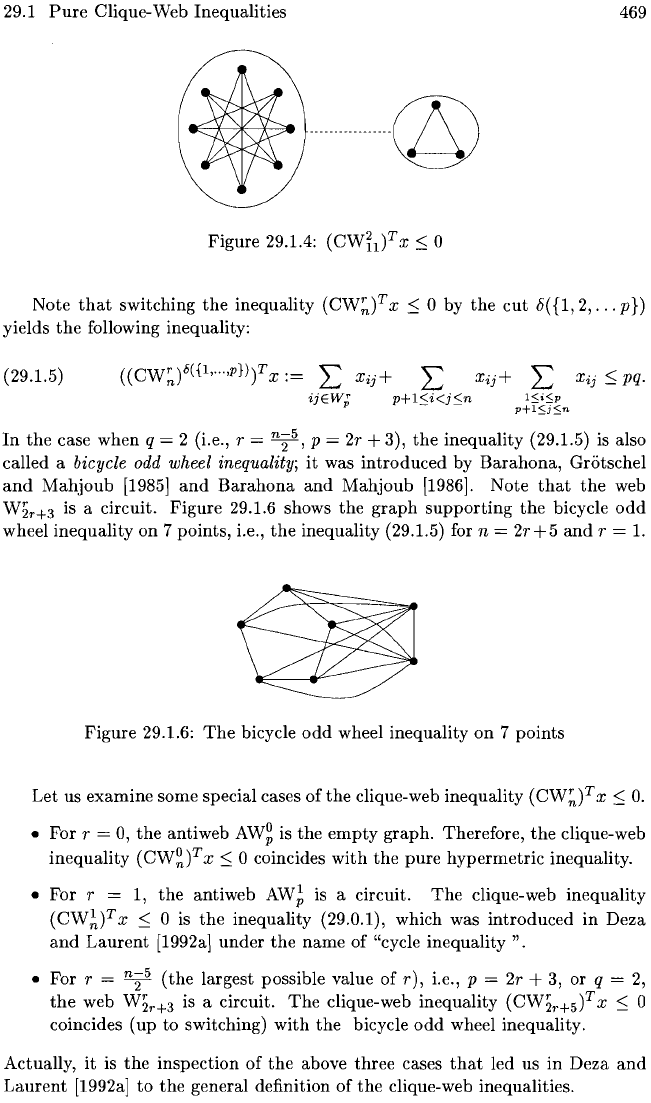
29.1
Pure
Clique-Web Inequalities
469
Note
that
switching
the
inequality
(CW~)T
x
~
0 by
the
cut
o(
{I,
2,
...
p})
yields
the
following inequality:
(29.1.5)
((CW~)8({1,···,p})f
x:=
L
Xij+
L
Xij+
L
ijEW;
p+l:<;i<j:<;n
l<i<p
p+l:sj:Sn
Xij
~
pq.
In
the
case when q = 2 (i.e., r = n
2
5,
p = 2r + 3),
the
inequality (29.1.5)
is
also
called a
bicycle odd wheel inequality;
it
was introduced by
Barahona,
Grotschel
and
Mahjoub
[1985]
and
Barahona
and
Mahjoub
[1986]. Note
that
the
web
W
2r
+
3
is a circuit. Figure 29.1.6 shows
the
graph
supporting
the
bicycle
odd
wheel inequality
on
7 points, i.e.,
the
inequality (29.1.5) for n =
2r+5
and
r =
1.
Figure
29.1.6:
The
bicycle
odd
wheel inequality
on
7
points
Let us examine some special cases
of
the
clique-web inequality
(CW~f
x
~
o.
• For r =
0,
the
antiweb
AWg
is
the
empty
graph. Therefore,
the
clique-web
inequality
(CW~)T
x
~
0 coincides
with
the
pure
hypermetric
inequality.
• For
r =
1,
the
antiweb
AW~
is
a circuit.
The
clique-web inequality
(CW~)T
x
~
0
is
the
inequality (29.0.1), which was introduced
in
Deza
and
Laurent
[1992a]
under
the
name
of "cycle
inequality".
• For r = n
2
5
(the
largest possible value of
r),
i.e., p = 2r + 3, or q =
2,
the
web W;r+3 is a circuit.
The
clique-web inequality (CW;'.+5)T x
~
0
coincides (up to switching) with
the
bicycle
odd
wheel inequality.
Actually,
it
is
the
inspection
of
the
above
three
cases
that
led us
in
Deza
and
Laurent
[1992a]
to
the
general definition
of
the
clique-web inequalities.
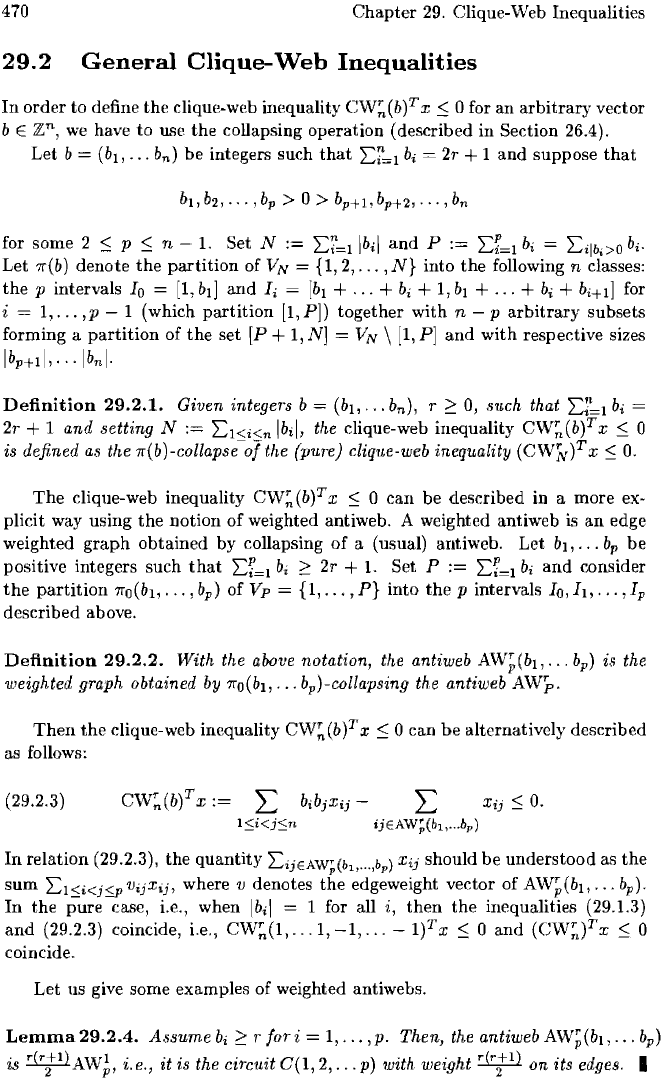
470
Chapter
29. Clique-Web Inequalities
29.2
General
Clique-Web
Inequalities
In
order
to define the clique-web inequality
CW~(b)T
x::; 0 for an
arbitrary
vector
bE
zn,
we
have
to
use the collapsing operation (described in Section 26.4).
Let b =
(b
l
,
...
b
n
) be such
that
b;
2r + 1
and
suppose
that
for some 2
::;
p
::;
n 1. Set N
Ib;1
and
P
:=
Lf=1
bi
=
L;jb,>O
b
i
•
Let
1f(b)
denote
the
partition
of V N {I,
2,
...
,N}
into
the
following n classes:
the
p intervals
10
=
[1,
bll and Ii
[b
i
+ ... +
bi
+
1,
bl
+ ... +
b;
+ bi+d for
i =
1,
...
,p
- 1 (which
partition
[1,
PJ) together with n p
arbitrary
subsets
forming a
partition
of
the
set
[P
+
1,
N]
V;v
\
[1,
Pj
and
with respective sizes
Ibp+ll,·· ·Ibnl·
Definition
29.2.1.
Given integers b
(bl"
..
b
n
),
r
2:
0, such that L7=1
bi
=
2r + 1 and setting N
:=
Ll<i<n
Ibil,
the
clique-web inequality
CW~(b)T
x
~
0
is
defined
as
the Jr(b)-collapse-ol the (pure) clique-web inequality (CWN)T x
~
o.
The
clique-web inequality
CW~(b)T
x
::;
0
can
be described in a more ex-
plicit way using
the
notion
of
weighted antiweb. A weighted antiweb is
an
edge
weighted
graph
obtained by collapsing
of
a (usual) antiweb. Let b
l
,
...
b
p
be
positive integers such
that
Lf=l
b;
2:
2r + 1. Set P
bi
and
consider
the
partition
1fO(bb'" ,b
p
) of Vp =
{I,
...
,P}
into the p intervals
Io,h,
...
,Ip
described above.
Definition
29.2.2.
With the
above
notation, the antiweb
AW~(bl"
.,
b
p
)
is
the
weighted graph obtained
by
Jro(bl,
...
bp)-collapsing the antiweb
AW
p
.
Then
the clique-web inequality
CW~(b)T
x::; 0 can
be
alternatively described
as follows:
(29.2.3)
Xij
~
O.
l:::;i<jS;n
In
relation (29.2.3), the quantity LijEAW;(bl,
..
"b
p
)
Xij
should be understood as
the
sum
VijX,j,
where v denotes the edgeweight vector of
AW~(bl""
b
p
).
In
the pure case, i.e., when
Ib;1
= 1 for all i,
then
the
inequalities (29.1.3)
and
(29.2.3) coincide, i.e.,
CW~(I,
...
1,
-1,
..
, -
I)T
X
::;
0 and
(CW~?
x
~
0
coincide.
Let us give some examples of weighted antiwebs.
Lemma29.2.4.
A.ssume
bi
2:
r
fori
= 1,
...
,po
Then, the antiweb
AW;(bl,'"
b
p
)
,
r(r+l)
'W
l
'
't'
th '
't
G(1 2 ) 'th ' ht
r(r+I)
't
d I
'LS
2
.~
p,z.e.,z
zs
eczrcm "
...
p
wz
wezg
2
onzsege.s.
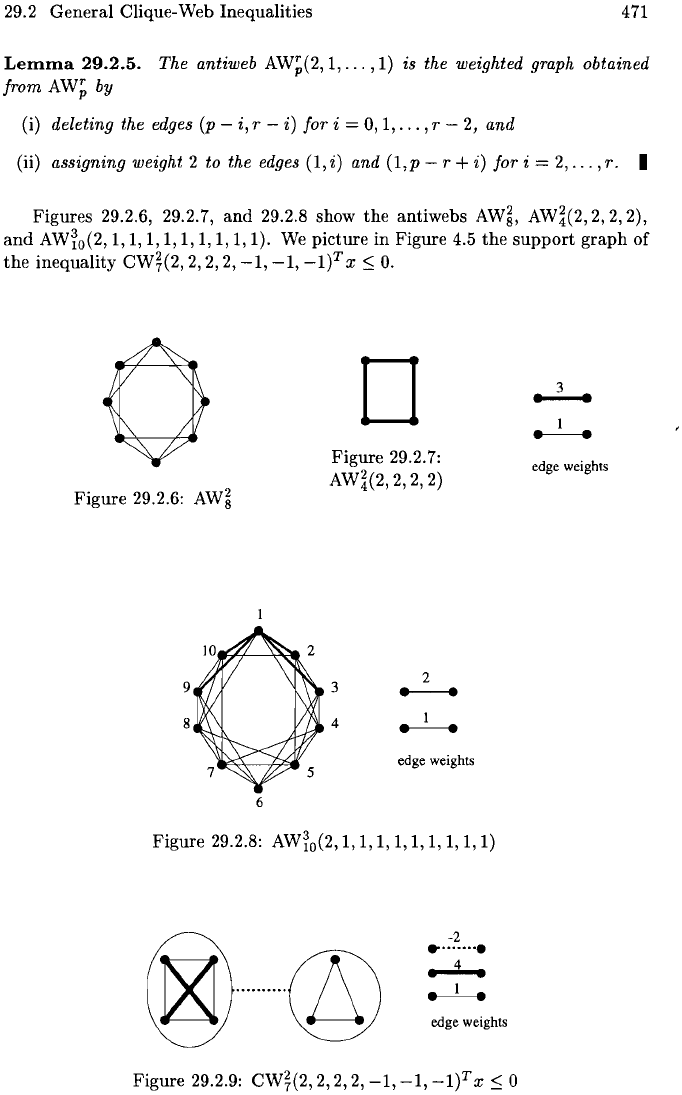
29.2
General
Clique-Web Inequalities
471
Lemma
29.2.5.
The
antiweb AW;(2,
1,
...
,1)
is the weighted graph
obtained
from
AW;
by
(i)
deleting the edges (p - i, T - i)
fOT
i = 0, 1,
...
,T
- 2,
and
(ii)
assigning
weight 2 to the edges
(1,i)
and
(1,p
- T + i)
fOT
i =
2,
...
,T.
I
Figures 29.2.6, 29.2.7,
and
29.2.8 show
the
antiwebs
AW~,
AW~(2,
2,
2,
2),
and
AWro(2, 1,
1,
1, 1, 1,
1,
1,
1,
1). We picture
in
Figure 4.5
the
support
graph
of
the
inequality
CW¥(2,
2,
2, 2,
-1,
-1,
_1)T x
:s;
O.
Figure
29.2.6:
AW~
9
6
o
Figure 29.2.7:
AW~(2,
2, 2,
2)
3
4
2
e------e
I
e------e
edge weights
Figure 29.2.8: AWro(2, 1, 1, 1,
1,
1,
1,1,1,1)
@
........
@
-2
..........
~
.-!--.
edge weights
Figure 29.2.9: CW¥(2,
2, 2, 2,
-1,
-1,
_1)T x
:s;
0
edge weights
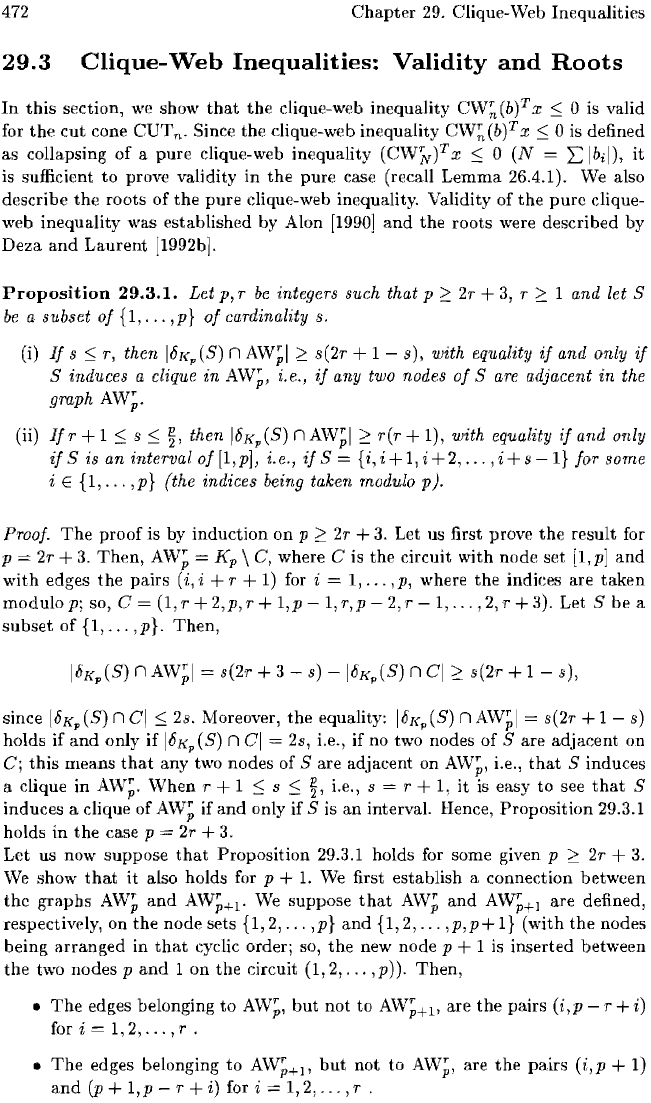
472
Chapter
29. Clique-Web Inequalities
29.3
Clique-
Web
Inequalities:
Validity
and
Roots
In
this
section, we show
that
the
clique-web inequality
CW~(b)Tx
::;
0 is valid
for
the
cut
cone
CUT
n'
Since the clique-web inequality
CW~
(b)T x
::;
0 is defined
as collapsing
of
a
pure
clique-web inequality
(CW~v)T
x
::;
0
(N
= L Ibi!),
it
is sufficient
to
prove validity in
the
pure case (recall
Lemma
26.4.1).
We
also
describe
the
roots
of
the
pure
clique-web inequality. Validity
of
the
pure
clique-
web inequality was established by Alon
[1990]
and
the roots were described by
Deza
and
Laurent
[1992bJ.
Proposition
29.3.1.
Let
p, r
be
integers such
that
p
?:
2r +
3,
r
?:
1
and
let S
be
a
subset
of
{I,
...
,p}
of
cardinality s.
(i)
If
s
::;
r,
then
IOKp(S)
n
AW~I
?:
s(2r
+ 1 s), with equality
if
and
only
if
S induces a clique
in
AW~!
i.e.,
if
any two nodes
of
S are adjacent
in
the
graph
AW;.
(ii)
1fr
+
1::;
s::;
~,
then
IOKp(S)
nAw;1
?:
r(r
+ 1), with equality
if
and
only
if
S is an
interval
of
[1,
p],
i.
e.,
if
S {i, i +
1,
i +
2,
...
, i + s - I}
for
some
i E {I,
...
,p}
(the indices being taken modulo
p).
Proof.
The
proof
is by induction on P
?:
2r +
3.
Let us first prove
the
result for
P
= 2r +
3.
Then,
AW;
= Kp \ C, where C is
the
circuit
with
node set [l,pJ
and
with
edges the pairs (i, i + r +
1)
for i = 1,
...
,p, where
the
indices are
taken
modulo
Pi so, C = (1, r +
2,p,
r +
1,p
-
1,
r,p
-
2,
r
1,
...
,2,
r + 3). Let S
be
a
subset
of
{I,
...
,p}.
Then,
IOK,,(S)
n AW;I =
s(2r
+ 3 - s) -IOK,,(S) n
CI
?:
s(2r
+ 1
s),
since
IOK,,(S)
n
CI
::;
2s. Moreover,
the
equality;
IOKl'(S)
n AW;I
s(2r
+ 1 s)
holds if
and
only
if
IOK,,(S)
n
CI
=
28,
i.e.,
if
no two nodes
of
S are adjacent on
Ci
this
means
that
any two nodes
of
S are adjacent on AW;, i.e.,
that
S induces
a clique in
AW;.
When
r + 1
::;
s
::;
~,
i.e., 8 = r +
I,
it
is
easy
to
see
that
S
induces a clique
of
AW;
if
and
only
if
S is
an
interval. Hence, Proposition 29.3.1
holds
in
the
case P 2r + 3.
Let us now suppose
that
Proposition 29.3.1 holds for some given p
?:
2r +
3.
We
show
that
it also holds for p +
1.
We
first establish a connection between
the
graphs
AW;
and
AW;+l'
We
suppose
that
AW;
and
AW;+l
are defined,
respectively, on
the
node sets
{I,
2,
...
,p}
and
{I,
2,
...
,p,p+
I}
(with
the
nodes
being aTranged
in
that
cyclic order; so, the new node p + 1 is inserted between
the
two nodes p
and
1 on the circuit (1,2,
...
,p)).
Then,
•
The
edges belonging
to
AW~,
but
not to
AW;+l'
are
the
pairs
(i,p
r + i)
for
i 1,
2,
...
,r
.
•
The
edges belonging
to
AW~+l'
but
not to AW;, are
the
pairs
(i,p
+ 1)
and
(p
+
1,p
r + i) for i 1,2,
...
, r .
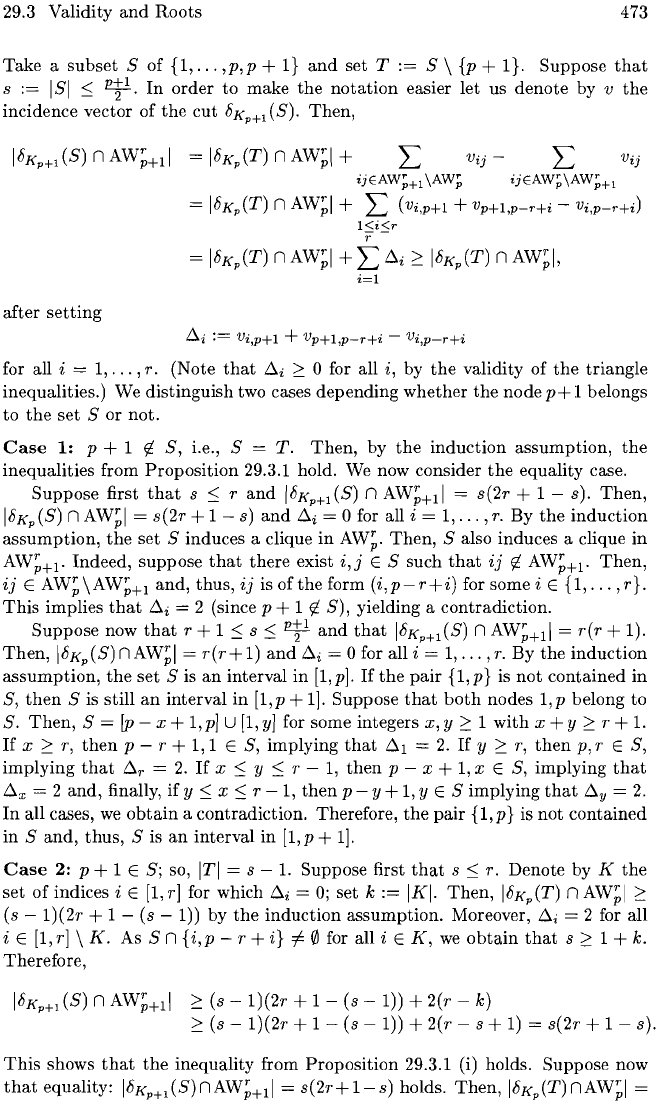
29.3 Validity
and
Roots
473
Take a
subset
S of
{I,
...
,p,p
+
I}
and
set T
:=
S \ {p +
I}.
Suppose
that
8
:=
lSI
::;
~.
In
order
to
make
the
notation
easier let us
denote
by v
the
incidence vector of
the
cut
8
Kp
+l
(S).
Then,
1
8
K
p
+l
(S) n
AW;+ll
=
18
Kp
(T) n AW;I + L
Vij
- L
Vij
after
setting
ijEAW;+l
\AW;
ijEAW;\AW;+1
=
18
Kp
(T) n AW;I + L
(Vi,p+l
+ Vp
+1,p-r+i
-
Vi,p-r+i)
l:'Oi:'Or
r
=
18
Kp
(T)
n AW;I + L
6i
2:
18
Kp
(T)
n AW;I,
i=l
6i
:=
Vi,p+1 + Vp
+1,p-r+i
-
Vi,p-r+i
for all i = 1,
...
,
r.
(Note
that
6i
2:
0 for all i, by
the
validity of
the
triangle
inequalities.) We
distinguish
two cases
depending
whether
the
node
p+
1 belongs
to
the
set
S or
not.
Case
1: p + 1 ¢
S,
i.e., S =
T.
Then,
by
the
induction
assumption,
the
inequalities from
Proposition
29.3.1 hold. We now consider
the
equality case.
Suppose
first
that
8
::;
rand
18Kp+l(S)
n
AW;+ll
= 8(2r + 1 - 8).
Then,
18Kp
(S) n AW;I = 8(2r + 1 -
8)
and
6i
= 0 for all i = 1,
...
,r.
By
the
induction
assumption,
the
set S induces a clique
in
AW;.
Then,
S also induces a clique
in
AW;+l'
Indeed,
suppose
that
there
exist
i,j
E S such
that
ij
¢
AW;+l'
Then,
ij
E
AW;
\
AW;+l
and,
thus,
ij
is of
the
form
(i,p-r+i)
for some i E
{I,
...
,r}.
This
implies
that
6i
= 2 (since p + 1 ¢
S),
yielding a
contradiction.
Suppose
now
that
r + 1::; 8::;
~
and
that
18Kp+l(S)
n AW;+l1 =
r(r
+
1).
Then,
18
Kp
(S) n AW;I =
r(r+
1)
and
6i
= 0 for all i =
1,
...
,r. By
the
induction
assumption,
the
set
S is
an
interval
in
[1,
pl.
If
the
pair
{I,
p} is
not
contained
in
S,
then
S is still
an
interval
in
[1,p
+
1].
Suppose
that
both
nodes
l,p
belong
to
S.
Then,
S =
[p
- x + 1,
p]
U
[1,
y]
for some integers x, y
2:
1
with
x + y
2:
r +
1.
If
x
2:
r,
then
p - r +
1,1
E S,
implying
that
61
=
2.
If
y
2:
r,
then
p,
rES,
implying
that
6
r
=
2.
If
x
::;
y
::;
r -
1,
then
p - x + 1,
xES,
implying
that
6
x
= 2
and,
finally,
if
y
::;
x
::;
r
-1,
then
p - y + 1,
yES
implying
that
6
y
=
2.
In
all cases, we
obtain
a contradiction. Therefore,
the
pair
{I,
p} is
not
contained
in S
and,
thus,
S is
an
interval in [1,p +
1].
Case
2: p + 1 E S; so,
ITI
= 8 -
1.
Suppose
first
that
8
::;
r. Denote by K
the
set
of
indices i E
[1,r]
for which
6i
= 0; set
k:=
IKI.
Then,
18
Kp
(T)
nAW;I2:
(8
- 1)(2r + 1 -
(8
- 1)) by
the
induction
assumption.
Moreover,
6i
= 2 for all
i E
[1,r]
\K.
As
Sn
{i,p
-
r+i}
=1=
0 for all i E K,
we
obtain
that
82:
1
+k.
Therefore,
18Kp+l
(S) n AW;+l1
2:
(8
- 1)(2r + 1 - (8 - 1)) + 2(r - k)
2:
(8
- 1)(2r + 1 - (8 - 1)) + 2(r - 8 +
1)
= 8(2r + 1 - 8).
This
shows
that
the
inequality from
Proposition
29.3.1 (i) holds.
Suppose
now
that
equality: 18Kp+,(S)nAW;+11 =
8(2r+I-8)
holds.
Then,
18Kp(T)nAW;1 =
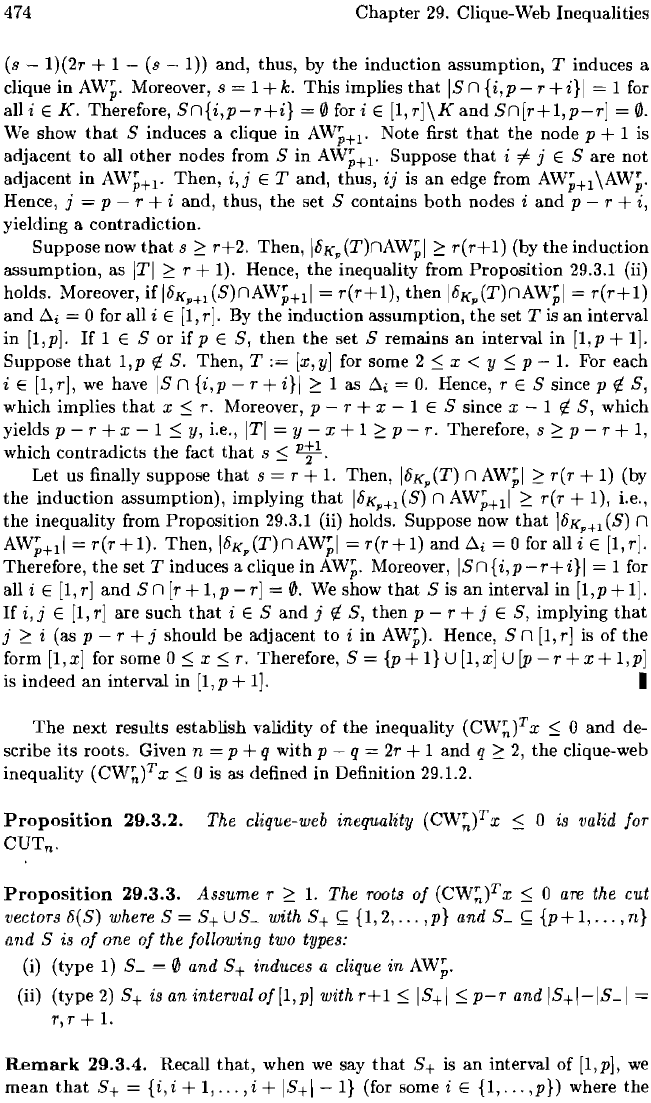
474
Chapter
29.
Clique-Web Inequalities
(8
1)(2r + 1
(8
1)) and, thus, by the induction assumption, T induces a
clique
in
AW;. Moreover, 8 = 1 +
k.
This implies
that
15
n
{i,p
r +i}1 = 1 for
all
i E
K.
Therefore,
5n{i,p-r+i}
= 0
for
i E
[l,rJ\K
and
5n[r+1,p-rJ
=
0.
We
show
that
5 induces a clique in AW;+1' Note first
that
the node p + 1
is
adjacent
to
all other nodes from 5
in
AW;+l' Suppose
that
i
i-
j E 5 are not
adjacent in
AW;+l'
Then,
i,j
E T and, thus,
ij
is
an
edge from AW;+1
\AW;.
Hence, j p - r + i and, thus,
the
set 5 contains
both
nodes i and p - r + i,
yielding a contradiction.
Suppose now
that
8
~
r+2. Then,
It5
Kp
(T)nAW;1
~
r(r+l)
(by the induction
assumption, as
ITI
~
r + 1). Hence,
the
inequality from Proposition 29.3.1 (ii)
holds. Moreover, iflt5Kp+1(5)nAW;+l1 =
r(r+I),
then
It5
Kp
(T)nAW;1 =
r(r+l)
and
Ai
= 0 for all i E
[1,
r]. By the induction assumption,
the
set T is
an
interval
in
[l,p].
If
1 E 5 or if p E
5,
then
the
set 5 remains an interval in
[I,p
+
1].
Suppose
that
l,p
t/:
5.
Then, T
[x,V]
for some 2:::; x < V
:::;
p - 1. For each
i
E
[1,
r],
we
have
15
n
{i,p
r +
i}1
~
1 as
Ai
O.
Hence, r E 5 since p
t/:
5,
which implies
that
x
:::;
r. Moreover, p r +
x-I
E 5 since
x-I
t/:
5,
which
yields
p - r +
x-I:::;
V,
i.e.,
ITI
= - x + 1
~
P - r. Therefore, s
~
p - r +
1,
which contradicts the fact
that
s
:::;
Let us finally suppose
that
s r +
1.
Then,
16Kp(T)
n AW;I
~
r(r + 1) (by
the
induction assumption), implying
that
16Kp+l(5)
n AW;+ll
~
r{r + 1), i.e.,
the
inequality from Proposition 29.3.1 (ii) holds. Suppose now
that
16Kp+!
(5) n
AW;+l1 =
r{r+I).
Then, IOKp(T)nAW;1 =
r(r+l)
and
Ai
= 0 for all i E [I,r].
Therefore,
the
set T induces a clique in AW;. Moreover,
15n{i,p-r+i}1
= 1 for
all
i E
[1,
rJ
and
5 n
[r
+
I,p
rJ
0.
We
show
that
5
is
an
interval in [I,p + 1].
If
i,j
E
[1,
r]
are such
that
i E 5 and j
t/:
5,
then p - r + j E
5,
implying
that
j
~
i (as p - r + j should be adjacent
to
i in AW;). Hence, 5 n
[1,
rJ
is
of
the
form [l,x] for some 0:::; x
:::;
r. Therefore, 5 =
{p
+ I} U
[1,x]
U
[p
- r + x + l,p]
is
indeed
an
interval in
[I,p
+
1].
I
The
next results establish validity
of
the inequality
(CW~)T
x
:::;
0 and de-
scribe its roots. Given
n p + q with p q =
2r
+ 1
and
q
~
2,
the
clique-web
inequality
(CW~)T
x:::;
0
is
as defined
in
Definition 29.1.2.
Proposition
29.3.2. The clique-web inequality
(CW~)T
x < 0
i.q
11alid
for
CUT
n
·
Proposition
29.3.3. Assume r
~
1. The roots
of
(CW~)T
x
:::;
0
are
the cut
vectors
15(5)
where
5 = 5+
u5_
with
5+
~
{I,
2,
...
,p}
and
5_
~
{p+I,
...
,n}
and 5
is
of
one
of
the following
two
types:
(i) (type 1)
5_
0 and
5+
induces a clique in AW;.
(ii) (type
2)
5+
is
an
interval of[l,p] with
r+I
:::;
15+1
:::;
p-r
and
15+1-15_1
r,
r + 1.
Remark
29.3.4.
Recall
that,
when
we
say
that
5+
is
an
interval of [I,pj,
we
mean
that
5+
=
{i,i
+
1,
...
,i
+
15+1-
I} (for some i E {I,
...
,p}) where the
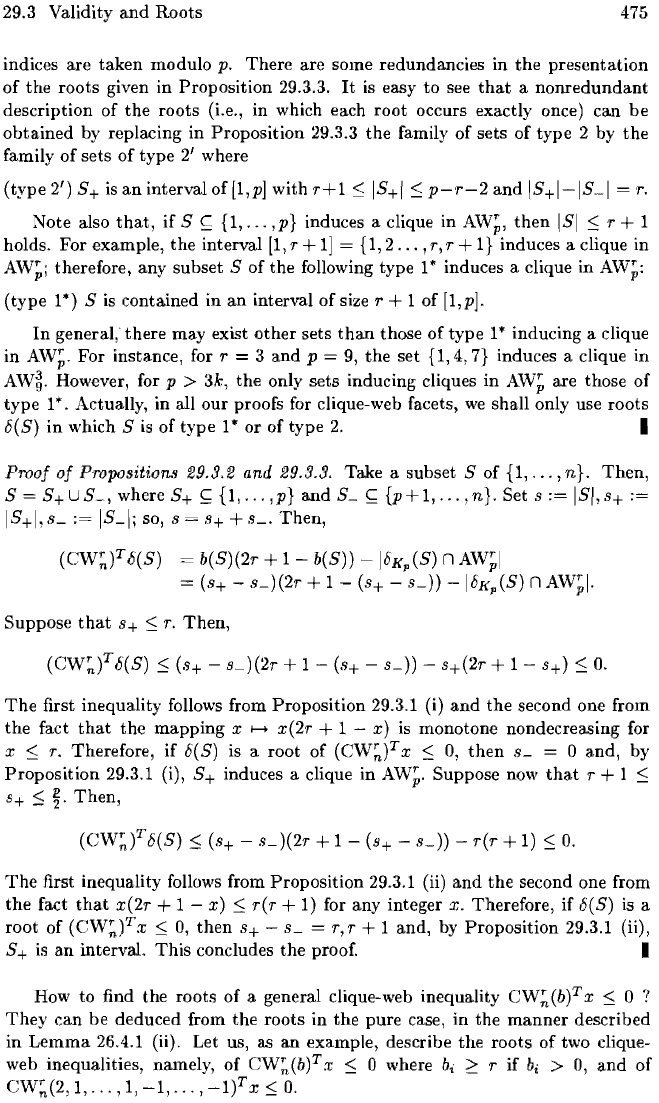
29.3 Validity
and
Roots 475
indices are taken modulo p. There are some redundancies in
the
presentation
of
the roots given
in
Proposition 29.3.3.
It
is easy
to
see
that
a nonredundant
description of the roots (Le., in which each root occurs exactly once) can
be
obtained by replacing in Proposition 29.3.3 the family
of
sets
of
type
2 by
the
family
of
sets of type 2' where
(type2')S+
is
an
interval
of[l,p]
withr+1:::;
IS+I:::;
:-.rote
also
that,
if S
s:;;
{I,
...
,p} induces a clique in AW;,
then
lSI:::; r + 1
holds. For example, the interval
[1,
r +
1]
{1,2
...
,r, r + I} induces a clique in
AW;i therefore, any subset
S of the following type
I'
induces a clique in AW;:
(type
1*)
S
is
contained in
an
interval
of
sizer
+ 1 of [l,pj.
In
general, there may exist
other
sets
than
those
of
type
1*
inducing a clique
in
AW;. For instance, for
'I'
3
and
p
9,
the set {I, 4,
7}
induces a clique in
AW~.
However, for p > 3k, the only sets inducing cliques in AW; are those of
type
1*.
Actually, in all our proofs for clique-web facets,
we
shall only use roots
15(S)
in
which S is
of
type
1*
or of
type
2.
I
Proof
of
Propositions 29.3.2 and 29.3.3. Take a subset S
of
{I,
...
,n}.
Then,
S =
S+
uS_,
where
s:;;
{I,
...
,p}
and
S_
s:;;
{p+
1,
...
,
n}.
Set s
:=
lSI,
s+
:=
IS+I,L:=
IS_I; so, s
s+
+L.
Then,
b(S)(2r + 1 - b(S))
I15KI'(S)
n AW;I
(s+
L)(2r
+ 1
(s+
L))
-115KI'(S) n AW;I.
Suppose
that
s+
:::;
r.
Then,
The
first inequality follows from Proposition 29.3.1 (i)
and
the second one from
the fact
that
the
mapping x
f-+
x(2r + 1 - x) is monotone nondecreasing for
x
:::;
r.
Therefore, if
15(S)
is a root of
(CW~)T
x
:::;
0,
then
L = 0 and, by
Proposition 29.3.1 (i),
S+
induces a clique in AW;. Suppose now
that
r + 1
:::;
8+
:::;
¥.
Then,
The
first inequality follows from Proposition 29.3.1 (ii)
and
the second one from
the
fact
that
x(2r + 1 - x)
:::;
1'(1'
+
1)
for any integer x. Therefore, if
15(S)
is a
root
of
(CW~)T
x
:::;
0,
then
s+
- L = r, r + 1 and,
by
Proposition 29.3.1 (ii),
S+
is
an
interval. This concludes the proof. I
How to find the roots of a general clique-web inequality
CW~(b)T
x
:::;
0 ?
They
can
be deduced from the roots in the pure case, in the manner described
in
Lemma
26.4.1 (ii). Let us, as
an
example, describe the roots of two clique-
web inequalities, namely,
of
CW~(b)T
x
:::;
0 where b
i
;::::
'I'
if
b;
> 0,
and
of
CW~(2,
1,
...
,1,
-1,
...
)
-1)T
x:::;
O.
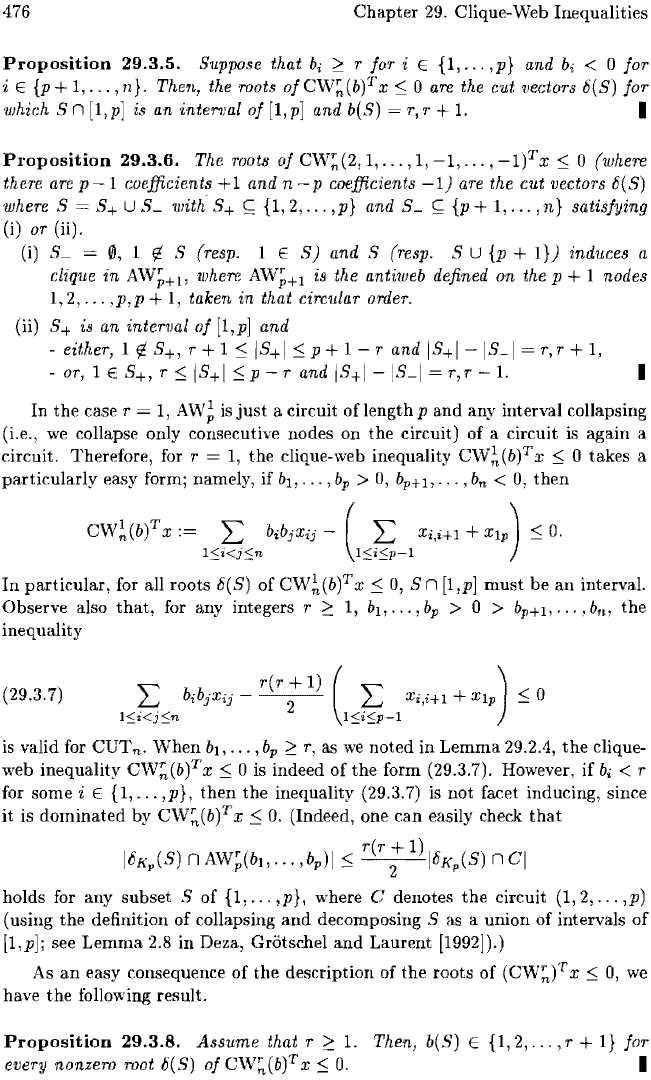
476
Chapter
29.
Clique-Web Inequalities
Proposition
29.3.5.
Suppose
that
b;
2::
r
for
i E
{I,
...
,p}
and
b;
< 0
for
i E {p + 1,
...
, Then, the roots
of
CW~(b)T
x
~
0 are the
cut
vectors
8(S)
for
which S n
[1,p]
is
an
interval
of
[1,p]
and
b{S) = r, r +
1.
I
Proposition
29.3.6.
The roots
of
CW~
(2,
1,
...
,1,
-1,
...
,
_1)T
x
~
0 (where
there are p
1 coefficients + 1
and
n - p coefficients
-1)
are the
cut
vectors
8(S)
where S S+ U
S_
with
{I,
2,
...
,p}
and
S_
~
{p
+ 1,
...
,n}
satisfying
(i)
or
(ii).
(i)
S_
0,
1
'I.
S (resp. 1 E
S)
and
S (resp. S U
{p
+
I})
induces a
clique
in
AW~+I'
where AW;+1 is the antiweb defined
on
the p + 1 nodes
1,2,
...
,p,
p +
1,
taken
in
that
circular order.
(ii) is an
interval
of
[1,p]
and
either, 1'1. S+, r + I
~
IS+I
~
p + 1 -
rand
IS+I-IS-I = r, r + 1,
or, 1 E S+, r
~
IS+I
~
p -
rand
IS+I
-IS_I
= r, r - 1. I
In
the
case r = 1, A
W!
is
just
a circuit of length p
and
any interval collapsing
(i.e.,
we
collapse only consecutive nodes
on
the circuit)
of
a circuit is again a
circuit. Therefore, for
r = 1, the clique-web inequality
CW~(b)T
x
~
0 takes a
particularly
easy form; namely, if b
1
,
...
,b
p
> 0, b
p
+
1
,'"
,b
n
< 0,
then
CW~(bl
x
:=
L b;bjXij - ( L
Xi,i+l
+
XI
P
)
~
O.
1:Si<J'Sn
l'SiSp-1
In
particular,
for all roots
8(S)
of
CW~(bl
x
~
0,
S n
[1,p]
must
be
an
interval.
Observe also
that,
for any integers r
2::
1, b
1
,
...
, b
p
> 0 > b
p
+
l
,""
b
n
,
the
inequality
(29.3.7)
r(r+I)
( L )
".
b·b·x'·
-
X·
'+1
+
Xl
< 0
~
'J
'J
2
','
p-
IS,<jSn
l'Si'Sp-1
is valid for
CUT
n
•
When
b
l
,
...
, b
p
2::
r,
as
we
noted in
Lemma
29.2.4,
the
clique-
web inequality
CW~
(b)T x
~
0 is indeed
of
the
form (29.3.7). However,
if
b;
< r
for some i E
{I,
...
,p},
then
the
inequality (29.3.7) is
not
facet inducing, since
it
is
dominated
by
CW~(bl
x
~
O.
(Indeed, one can easily check
that
nC[
holds for any subset S
of
{l,
...
,p}, where C denotes
the
circuit (1,2,
...
,p)
(using
the
definition
of
collapsing
and
decomposing S as a union of intervals
of
[1,p); see
Lemma
2.8 in Deza, Grotschel
and
Laurent [1992]).)
As
an
easy consequence
of
the
description of
the
roots
of
(CW~fr
x
~
0,
we
have
the
following result.
Proposition
29.3.8.
Assume
that
r
2::
1. Then,
b(S)
E
{I,
2,
...
,r
+ I}
for
every
nonzero root
8(S)
of
CW~(b)T
X
~
o.
I
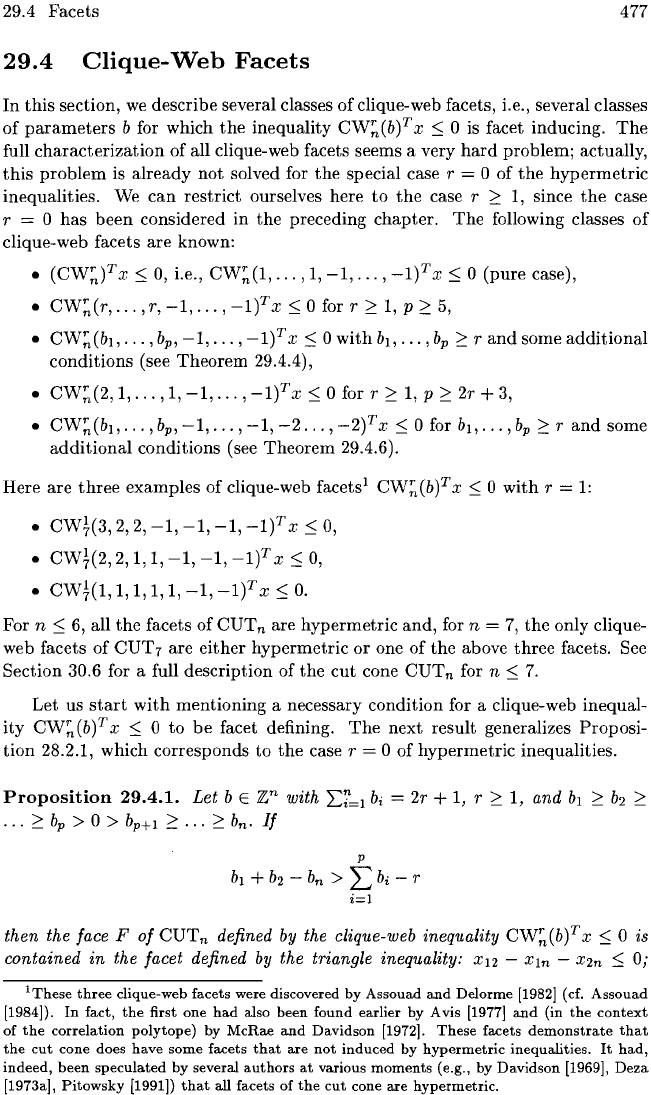
29.4 Facets
477
29.4
Clique-
Web
Facets
In
this
section,
we
describe several classes
of
clique-web facets, Le., several classes
of
parameters
b for which
the
inequality
CW~(b)T
x SO is facet inducing.
The
full
characterization
of
all clique-web facets seems a very
hard
problem; actually,
this
problem
is
already
not
solved for
the
special case r = 0
of
the
hypermetric
inequalities. We
can
restrict
ourselves here to
the
case r
:2':
1,
since
the
case
r = 0
has
been
considered
in
the
preceding chapter.
The
following classes
of
clique-web facets are known:
•
(CW~)T
x S
0,
Le.,
CW~(I,
...
,
1,
-1,
...
,
_1)T
X S 0 (pure case),
•
CW~(r,
...
, r,
-1,
...
,
_1)T
X S 0 for r
:2':
1,
P:2':
5,
•
CW~(b1"'"
b
p
,
-1,
...
,
-ll
x S 0
with
b
1
,
•••
, b
p
:2':
r
and
some
additional
conditions (see
Theorem
29.4.4),
•
CW~(2,
1,
...
,1,
-1,
...
,
-1)Tx
S 0 for
r:2':
1,
P:2':
2r +
3,
•
CW~(b1"'"
b
p
,
-1,
...
,
-1,
-2
...
,
_2)T
X S 0 for b
1
,
...
, b
p
:2':
r
and
some
additional
conditions (see
Theorem
29.4.6).
Here are
three
examples
of
clique-web facets1
CW~(b
l x S 0
with
r =
1:
•
CWi(3,
2, 2,
-1, -1, -1,
_1)T
x S
0,
•
CWi(2,
2,
1, 1,
-1,
-1,
_1)T
x S
0,
•
CWi(l,
1,
1,
1, 1,
-1,
_1)T
x S
O.
For n S 6, all
the
facets
of
CUT
n are hypermetric
and,
for n =
7,
the only clique-
web facets
of
CUT
7
are
either
hypermetric
or
one
of
the above
three
facets. See
Section 30.6 for a full description of
the
cut
cone
CUTn
for n S
7.
Let
us
start
with
mentioning a necessary condition for a clique-web inequal-
ity
CW~
(b)T x S 0 to
be
facet defining.
The
next result generalizes Proposi-
tion 28.2.1, which corresponds to
the
case r = 0
of
hypermetric inequalities.
Proposition
29.4.1.
Let
b E
zn
with
l:i=l
bi
= 2r + 1, r
:2':
1,
and
b
1
:2':
b
2
:2':
•..
:2':
b
p
> 0 >
bp+l
:2':
•.•
:2':
b
n
·
If
P
b
1
+ b
2
-
b
n
> L
bi
- r
i=l
then
the face F
of
CUTn
defined by the clique-web inequality
CW~(bl
x S 0 is
contained
in
the facet defined by the triangle inequality:
X12
-
Xln
-
X2n
S
0;
lThese
three
clique-web facets were discovered
by
Assouad
and
Delorme
[1982] (cf.
Assouad
[1984]).
In
fact,
the
first
one
had
also
been
found
earlier
by
Avis [1977]
and
(in
the
context
of
the
correlation
polytope)
by
McRae
and
Davidson
[1972].
These
facets
demonstrate
that
the
cut
cone
does
have
some
facets
that
are
not
induced
by
hypermetric
inequalities.
It
had,
indeed,
been
speculated
by
several
authors
at
various
moments
(e.g.,
by
Davidson
[1969],
Deza
[1973a]'
Pitowsky
[1991])
that
all facets
of
the
cut
cone
are
hypermetric.
